In this Rajasthani haveli, do as the Royals do
Every nook and cranny of Samode Haveli in Jaipur whispers tales of regal splendour


While strolling through the labyrinthine passages of Samode Haveli, you can almost hear the echoes of laughter and music that once filled these inalienable halls. Straight out of a movie scene, this over two-centuries-old haveli steeped in history and opulence was once the exclusive domain of the privileged few. However, this epitome of refinement is now open to curious travellers, inviting them to step into a world of timeless beauty and captivating stories. The Samode Haveli in Jaipur exudes an aura of grandeur that only 225 years of history can bestow. Its grand entrance is a testament to its glorious heyday when its foundation was laid by the illustrious Rawals of Samode, forever etching their legacy into the annals of time.
Samode, a large town in Rajasthan, boasts a rich history of the mighty zamindars. These landlords, the principal thinkers of the state of Amber (Amer), held sway over parts of Rajasthan. The Thakur lineage, tracing back to the illustrious Maharaja Rajveer Singhji, the 17th prince of the esteemed house of Kacchwaha Rajputs, first put Samode on the map. However, under the rule of the British Raj, Samode was handed to the Nathawat clan, with the prestigious title of Rawal Saheb or Maha Rawal. The village and the title was bestowed upon them for their unwavering valiance and this lineage continues to thrive even to this very day.
“The Rawal clan played an integral role in the court of Jaipur including serving as the prime minister of the state for which they were awarded a prominent location for residence within the walled city. Like any noteworthy and erstwhile royal stately mansion, Samode Haveli has over the years hosted its fair share of dignitaries, social events and galas. Today, the Haveli gracefully embraces a dual identity as both a private residence for the family and as a luxury boutique hotel that continues to carry forward its long-standing tradition of extending ‘the quintessential Samode hospitality’ to global travellers. But one of my first recollections around the Haveli has been of my time playing cricket with family in the gardens next to the pool," says Rawal Yadavendra Singh, director of Samode Hotels, and a descendant of the family. The family continues to keep the top two floors of the haveli as their residence, shuttling between their three royal residences, Samode Palace, Samode Bagh and Samode Haveli, all in Jaipur.
What sets this haveli apart from the rest is its impeccable preservation, but this royal residence is not just a mere relic of the past, it is a living, breathing testament to the timeless allure of Jaipur. Being the ancestral home to the family, the Haveli interiors have been maintained to the greatest degree. The majority of the three-dimensional paintings and photographs at the Haveli date back to the late 1800s and speak of stories associated with the history of Samode. Most of the sheesham and teak wood furniture in the common areas is antique, including five standout cabinets and 15 trunks that belong to the family.
Rawal Yadavendra says, “The architectural and interior elements that you see at the Haveli stand as an epitome of traditional Rajputana design with influences of Indo-Saracenic grandeur. From the intricately inlaid doors, delicate filigree work, ethereal mural work, arched doorways, and courtyards to the jharokhas, the haveli tells a tale of artistic mastery and cultural fusion. The Palace and the Haveli were master crafted by masons and artisans who back then came from the Kumawat community from the Samode village. This community of artists and skilled painters today continue to be a part of Samode history and the ongoing conservation story—we continue to associate with them for all the restoration, renovations and touch-ups that are required across the Samode properties in Rajasthan."
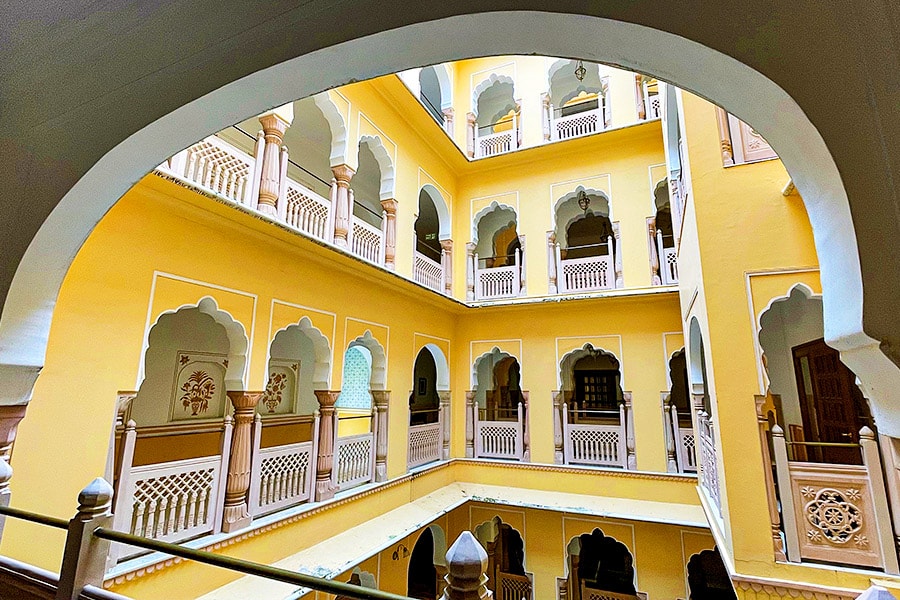 The hanging balconies overlook the central courtyardImage: Veidehi Gite
The hanging balconies overlook the central courtyardImage: Veidehi Gite
Beyond the aesthetic allure, Samode Haveli also serves as a living museum, preserving the customs and traditions of the grand lifestyles of the erstwhile rulers. As you proceed towards the rooms, a central courtyard with hanging balconies appears in front of you. Women of yore gazed down from these very balconies, observing the grandeur of wedding processions and official affairs.
“The first Royal wedding at Samode Haveli was back in the 1950s when my aunt Rajkumari Indra Kanwar got married to Maharaj Sobhag Singhji of Jodhpur. Thereafter, our late father Rawal Rajeshwar Singhji married Rajkumari of Bhavnagar, Gujarat," Rawal Raja Raghavendra Singh, the co-director of Samode Hotels, tells Forbes India.
Also read: Sacred simplicity and the Tamizh way of life
While embracing the luxurious amenities of a five-star hotel, the Haveli still manages to preserve pockets of its regal, old-world charm. The entrance, for instance, is a fully carved inlaid door that lets you into the world of royalty. But there is more to this entrance than meets the eye. In the 1950s, Maharaja Sobhag Singhji rode in on an elephant for his wedding, and the owners decided to keep the original ramp to welcome patrons just the same way. Walk around inside, where bursts of bougainvillaea and pomegranate dot the landscape and hidden alcoves await you at every corner. Within a verdant courtyard, adorned with intertwining waterways and champa trees, a delightful spectacle unfolds. Vibrant hues of blue and orange dance in perfect harmony, contrasting against a pastel backdrop. Further in, a magnificent living room awaits, where the walls are adorned from floor to ceiling with hand-painted illustrations, dating back to the illustrious 18th century.
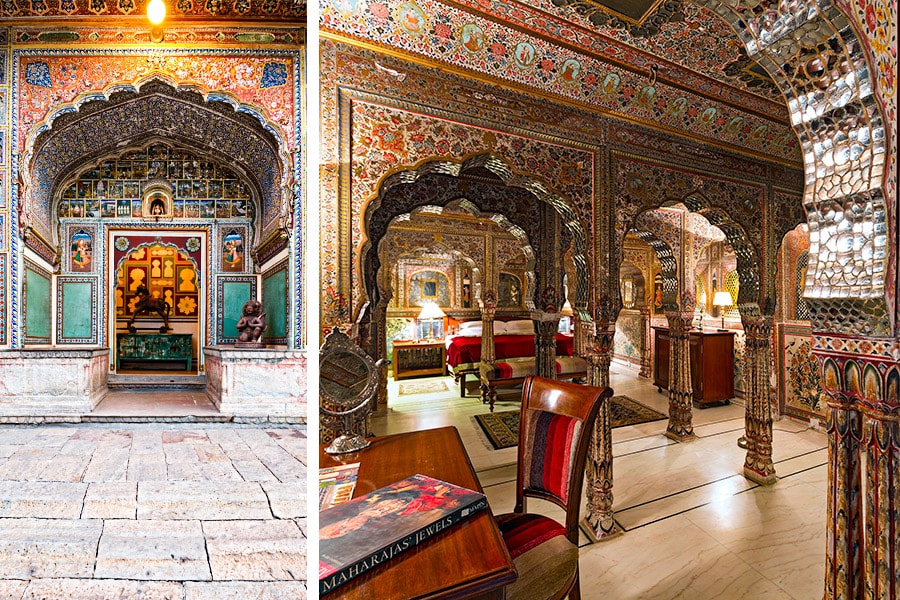 The elephant ramp leads to the entrance with its fully carved inlaid door Sheesh Mahal suite at Samode Haveli
The elephant ramp leads to the entrance with its fully carved inlaid door Sheesh Mahal suite at Samode Haveli
Rawal Raja Raghavendra Singh says, "The intricately designed living/drawing room with its frescoes (in which water-based earth pigments are hand-painted directly on fresh lime plaster/araish) is my personal favourite. [It is] where the guests at Samode Haveli thoroughly enjoy the grand welcome that awaits them upon arrival. As a child I remember looking for monkeys that were so cleverly camouflaged within the mural paintings on the walls and on the ceiling as well."
The haveli has 50 rooms including 30 suites, and no two rooms in the haveli are alike when it comes to accommodation this is true of both the room layout and the furniture and accents. The Sheesh Mahal suite at Samode Haveli was inspired by the grand Sheesh Mahal at Samode Palace and the one at the City Palace in Jaipur. It was also the part of the house where the zenana (ladies) resided. Each Haveli suite greets you in a plush living room, taking you further into the bedroom with an attached powder room and bathroom. A Victorian bathtub beckons you to soak away your worries, and if that"s not enough, feast your eyes on a private deck, offering a serene escape from the world outside.
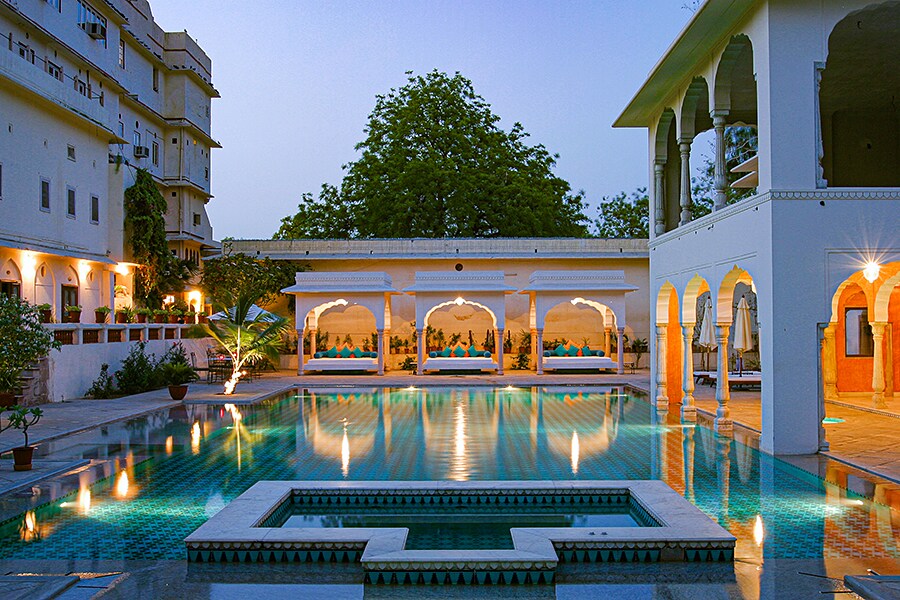 The refreshing pool, which is built atop what were formerly the royal stables
The refreshing pool, which is built atop what were formerly the royal stables
Dive into the refreshing waters of Jaipur"s most beautiful pool, which is built where formerly the royal stables were. Rejuvenate your senses with a curated therapy menu at the spa. We especially suggest the Signature Samode massage in which Niyaso Subba, the massage therapist, thoroughly kneads the body in warm lavender oil while using three massage combinations: Deep tissue, aromatherapy, and Swedish massage. Hit the well-equipped gym for an intense workout, or find your inner zen during the invigorating yoga sessions. After a day of self-care, treat yourself to a well-deserved drink at their well-stocked bar, all held together with a Hemingway-style décor and 24k gold-painted bar counter, replete with touches of transnational art.
Dining experiences are defined by an impressive menu of local delicacies as well as other Indian and global cuisines. “Samode Haveli is well recognised for its superb royal Rajasthani food. Laal Maas, Junglee Mass, and Khad Murgh are some of the traditional hunting delicacies that are a must-try. Whereas Dekchi Sula, Karela A Samode, Samode’s Dahi Baingan (roasted aubergine and yoghurt) and the Kashmiri chilli chocolate fondant are some of our in-house specialities," says Executive Chef Vijendra Singh. The Fateh Niwas serves as their main restaurant, where you can partake in local delicacies while being regaled with live instrumental sessions.
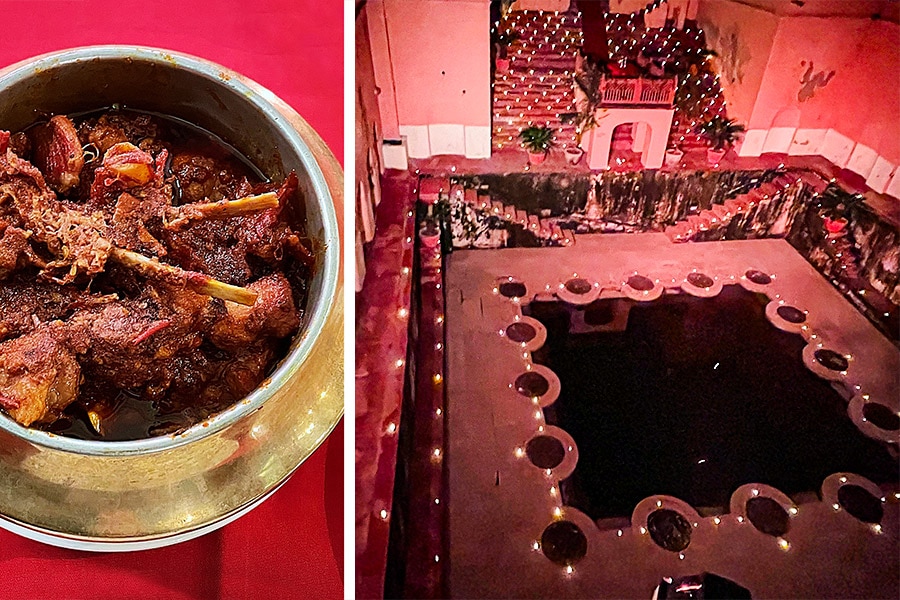 The Junglee Maas, a traditional hunting delicacy the Bawri is decorated with hundreds of diyas at nightCredit Veidehi Gite
The Junglee Maas, a traditional hunting delicacy the Bawri is decorated with hundreds of diyas at nightCredit Veidehi Gite
Yugdeep Singh Kableshwar, general manager of Samode Haveli says, “When it comes to environmentally friendly practices, Samode Haveli has its organic garden where we cultivate a variety of fruits and vegetables. However, in addition to that, we also buy our meat and veggies from nearby farmer"s markets to support the local farmers."
Samode Haveli is also the only hotel in Jaipur with its own bawri (step-well), which was built at the same time as the Haveli and was used for both drinking water and irrigation. It"s truly a mesmerising spectacle at night, when the bawri is decorated with hundreds of diyas, casting a spell of historical enchantment. The flickering lights transport you to a bygone era, where time seems to stand still. "It had 16 wells, but they dried out and were closed over time. The bawri, on the other hand, is still working and has a capacity of 58 thousand gallons of water. Formerly, it survived on rainwater, but today when the water level drops, the hotel replenishes it from its reserves. The Bawri temple worships Ram, Shiva, and Hanuman," says Kableshwar.
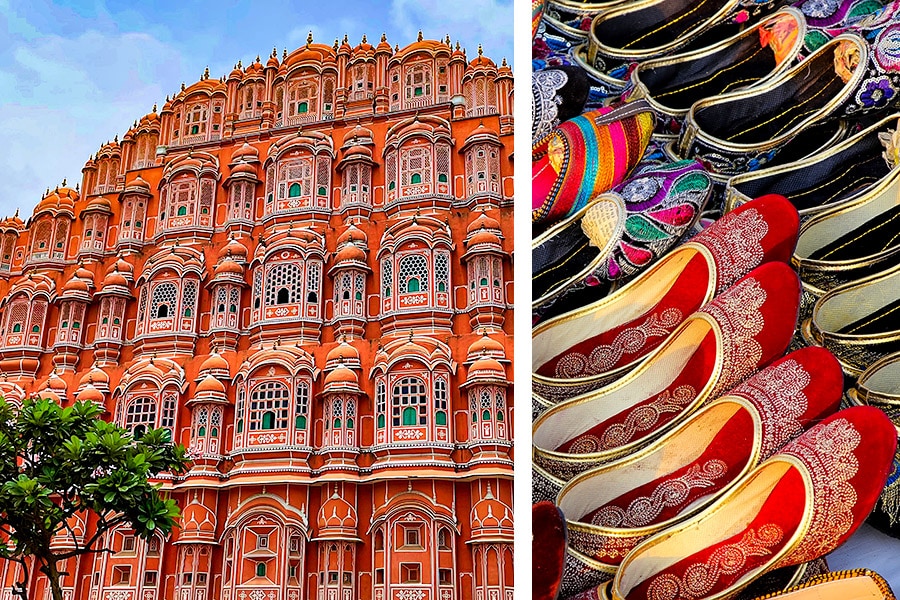 Hawa Mahal, Jaipur"s crown jewel handcrafted jhootis at a craft market in the city as Image: Shutterstock Veidehi Gite (right image)
Hawa Mahal, Jaipur"s crown jewel handcrafted jhootis at a craft market in the city as Image: Shutterstock Veidehi Gite (right image)
Tucked away within the pink ramparts of the old town, the city"s crown jewels of attractions—Hawa Mahal, City Palace, and Jantar Mantar—are just a stone"s throw away from Samode Haveli. The curated early morning walk will take you to the heart of the city as it awakens from its slumber. Stroll through crafts and farmer"s markets, immerse yourself in the soul-stirring bhajans, and indulge in the legendary samosa chaat at Pandit Ji. Oh, and the pià¨ce de resistance—the best cup of chai in town at the Sahu restaurant. The entire experience is more than just a mere visit it"s a grounding journey through the ancient city of temples, a chance to feel the pulse of the connected community that thrives within its historic lanes.
“The experiences at Samode Haveli like the morning walk and evening kite flying over tea are carefully deliberated and thought out to represent Jaipur city’s culture and the variety of living heritage that it possesses. These are essential elements of our cultural identity," says Kableshwar. This Haveli is a veritable playground for those seeking an immersive experience of royal grandeur. Football player Zinedine Zidane, actors Micheal Douglas, Akshay Kumar and Catherine Zeta-Jones are just a few renowned personalities who have enjoyed the royal hospitality at Samode Haveli.
First Published: Aug 26, 2023, 09:35
Subscribe Now